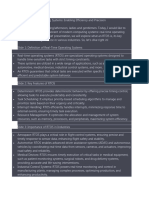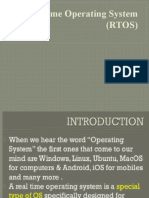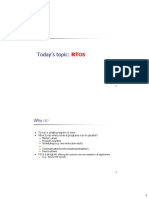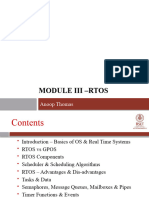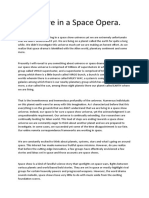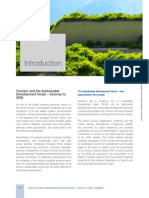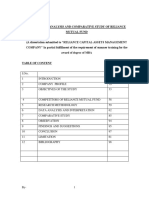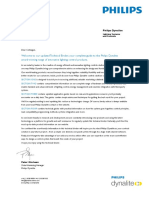JSS ACADEMY OF TECHNICAL EDUCATION
DEPARTMENT OF COMPUTER SCIENCE AND
ENGINEERING
COURSE NAME: OPERATING SYSTEM
COURSE CODE: BCS303
ASSIGNMENT-2
Report On Real Time Operating Systems
(3rd Semester)
Submitted by:
SUSHMA A (1JS23CS175)
RUCHITHA H P (1JS24CS(DIPLOMA))
Guided by:
Mrs. Ranjitha S R
Signature of the staff:
1
� Table of contents:
Sl no. Content Page no.
1 Introduction 3
2 Overview 4-5
3 Technical concepts 6-8
4 Key takeaways 9-10
5 Conclusion 11
2
� Introduction
The seminar on Real-Time Operating Systems (RTOS) was a pivotal event aimed at bridging
the gap between theoretical knowledge and practical application in the realm of embedded
systems and time-sensitive computing. Organized byJSSATE, this seminar attracted a wide
audience comprising students, faculty members, and professionals keen on understanding the
intricacies of RTOS and its role in the technology ecosystem.
The session was led by Mr. Mahammad Khalid Anwar Badal, Group Leader at Continental
Automotive Pvt Ltd, who brought a wealth of knowledge and industry experience to the
discussion. The speaker emphasized the growing importance of RTOS in enabling systems that
require high reliability, predictability, and efficiency. These systems are fundamental to modern
applications, from autonomous vehicles and industrial robotics to IoT devices and medical
instrumentation.
The seminar began with a contextual overview of operating systems and their evolution. The
guest speaker highlighted how traditional General Purpose Operating Systems (GPOS) cater to
general computing needs but fall short in real-time applications where stringent timing
constraints are non-negotiable. This set the stage for an in-depth exploration of RTOS, a
specialized operating system designed for such scenarios.
One of the key points emphasized was the deterministic behavior of RTOS, which ensures
tasks are executed within defined time limits. Unlike GPOS, which prioritizes fairness and
resource utilization, RTOS is optimized for predictability and time-critical task management.
This makes it indispensable in scenarios where delays or missed deadlines could lead to
catastrophic outcomes, such as in automotive braking systems or patient monitoring devices.
The speaker also shed light on the fundamental features of RTOS, such as task scheduling,
inter-task communication, and interrupt handling. These features enable RTOS to manage
concurrent tasks efficiently while ensuring priority-based execution. Real-world examples,
including its use in smart home devices, industrial machinery, and defense systems, helped
attendees grasp the practical applications of the concepts discussed.
A significant portion of the session was dedicated to exploring the current trends and
challenges in the field of RTOS. The integration of RTOS with emerging technologies like
Artificial Intelligence (AI), Machine Learning (ML), and Edge Computing was discussed
as a transformative trend, opening new possibilities for innovation. The speaker also addressed
challenges such as minimizing resource overhead, ensuring security in RTOS-based systems,
and maintaining real-time performance under increasing complexity.
3
� Technical talk Overview
The seminar began with an introduction to operating systems and their role in computing. The
focus then shifted to RTOS, highlighting its importance in systems where timely execution is
critical.
Key Highlights of the Seminar:
• Overview of RTOS and its necessity in real-time applications.
• Discussion on RTOS architecture and task scheduling mechanisms.
• Real-world applications of RTOS in industries such as automotive, IoT, and healthcare.
• Emerging trends, including AI-integrated RTOS and Industry 4.0 applications.
What is RTOS?
A Real-Time Operating System (RTOS) is a specialized operating system designed to
manage hardware and software resources to execute tasks within strict time constraints. It is
particularly critical in systems where failing to perform tasks on time can lead to severe
consequences, such as in automotive safety systems, industrial machinery, and medical devices.
Unlike General Purpose Operating Systems (GPOS) like Windows or Linux, which aim to
maximize throughput and resource utilization for non-critical applications, RTOS focuses on
deterministic behavior—ensuring that tasks are completed within defined deadlines. This
makes RTOS essential for real-time systems that operate under stringent timing and reliability
requirements.
Core Features of RTOS
1. Determinism
o Explanation: Determinism in RTOS means the system guarantees that operations
or tasks will be completed within a predictable and predefined timeframe. This
predictability is achieved through carefully designed scheduling algorithms that
prioritize tasks based on urgency and deadlines.
o Importance: Deterministic behavior is critical in applications such as:
▪ Industrial Robots: Tasks like welding, painting, or assembly must occur at
precise intervals to maintain accuracy.
▪ Medical Devices: Real-time patient monitoring systems must deliver timely
alerts to prevent potential life-threatening conditions.
2. Reliability
o Explanation: RTOS is engineered to handle multiple concurrent tasks efficiently
without delays or crashes, even under heavy workloads. It uses features like priority
4
� scheduling and task preemption to ensure that high-priority tasks are executed
promptly.
o Importance: Reliability is essential in:
▪ Automotive Systems: Anti-lock braking systems (ABS) and airbag
deployment require a dependable response to real-world triggers.
▪ Aerospace Systems: Flight control systems must operate seamlessly under
complex conditions.
3. Scalability
o Explanation: RTOS can be scaled to work with various hardware configurations
and system requirements, ranging from small microcontroller-based systems to
complex multi-core processors.
o Importance: Scalability enables RTOS to adapt to different applications, such as:
▪ Small Systems: Microcontrollers in smart sensors or wearable devices.
▪ Large Systems: Multi-core processors in autonomous vehicles or industrial
automation.
Other Key Characteristics of RTOS
1. Task Scheduling
o RTOS uses scheduling policies like preemptive scheduling (where higher-priority
tasks interrupt lower-priority tasks) or cooperative scheduling (where tasks
voluntarily yield control) to maintain strict timing.
2. Minimal Latency
o RTOS is optimized for quick response to external events, ensuring minimal latency
in handling interrupts or initiating task execution.
3. Resource Management
o Efficient use of CPU, memory, and peripherals ensures that critical tasks receive the
required resources without delay.
4. Inter-Task Communication and Synchronization
o RTOS includes mechanisms like semaphores, mutexes, and message queues to
allow tasks to communicate and share resources without conflicts or deadlocks.
5
� Technical Concepts Discussed in RTOS Seminar
The guest speaker delved into the foundational and technical aspects of Real-Time Operating
Systems (RTOS), highlighting critical components that make RTOS suitable for real-time and
embedded applications. These technical concepts are summarized and explained below:
1. RTOS Architecture
The architecture of an RTOS is designed to manage system resources efficiently while meeting
strict timing constraints. Key components include:
1.1. Kernel
• The kernel is the core of the RTOS and is responsible for managing the system's hardware
and software resources.
• Functions include task management, scheduling, interrupt handling, and memory
management.
• Types of Kernels:
o Monolithic Kernel: Combines all services, such as file systems and device drivers,
into a single program. It is efficient but less modular.
o Microkernel: Provides only essential services like task scheduling and inter-task
communication. Other services run in user space, improving modularity and fault
isolation.
1.2. Task Scheduler
• The task scheduler is responsible for deciding the order of task execution based on
predefined criteria like priority or deadlines.
• RTOS schedulers ensure tasks are completed within their timing constraints, maintaining
system predictability.
• Real-Time Tasks: Can be periodic (executed at regular intervals) or aperiodic (executed in
response to events).
1.3. Interrupt Handling
• Interrupts are external or internal signals that demand immediate attention.
• The RTOS must handle interrupts with minimal latency to avoid delays in time-critical
tasks.
• Interrupt Service Routine (ISR): A small program that executes in response to an
interrupt, ensuring high-priority tasks resume promptly.
6
�2. Task Scheduling Algorithms
Task scheduling is at the heart of RTOS functionality. The seminar covered two primary
scheduling methods:
2.1. Preemptive Scheduling
• In preemptive scheduling, tasks can interrupt or preempt lower-priority tasks to ensure
high-priority tasks are executed first.
• How It Works:
o The RTOS monitors task priorities continuously.
o If a higher-priority task becomes ready to execute, it interrupts the currently running
task.
• Advantages:
o Ensures critical tasks are completed on time.
o Efficient resource utilization in time-sensitive systems.
• Applications:
o Real-time medical devices where patient safety depends on timely responses.
o
2.2. Rate Monotonic Scheduling (RMS)
• RMS is a priority-based algorithm where tasks with shorter periods (i.e., tasks that require
frequent execution) are given higher priority.
• Assumptions:
o Tasks are periodic, with known execution times and deadlines.
o Deadlines coincide with the end of the task's period.
• How It Works:
o Tasks are prioritized based on their frequency of execution.
o The scheduler assigns higher priority to tasks with shorter cycles.
• Example:
o In an automotive system, checking engine temperature (high-frequency task) may
have a higher priority than updating dashboard displays (low-frequency task).
7
�3. Inter-Task Communication Mechanisms
RTOS provides mechanisms to ensure tasks can communicate and synchronize safely without
resource conflicts or deadlocks. Key methods discussed were:
3.1. Semaphores
• A semaphore is a signaling mechanism used to manage access to shared resources among
multiple tasks.
• Types of Semaphores:
o Binary Semaphore: Has two states (0 or 1) and is used to signal task completion
or resource availability.
o Counting Semaphore: Tracks multiple instances of a resource, allowing tasks to
access resources as they become available.
• Use Case: A robotic arm system where multiple tasks (grippers, motors) need controlled
access to a shared actuator.
3.2. Mutexes (Mutual Exclusion)
• A mutex is similar to a binary semaphore but includes ownership and priority inversion
handling.
• Purpose: Prevents multiple tasks from accessing a shared resource simultaneously,
ensuring data consistency.
• Example: A banking system where tasks updating account balances require exclusive
access to the account data.
3.3. Message Queues
• Message queues facilitate inter-task communication by allowing tasks to send and receive
messages in a predefined sequence.
• Advantages:
o Decouples sender and receiver tasks, allowing asynchronous communication.
o Ensures data is transferred in the correct order.
• Use Case: A smart home hub where various sensors (temperature, motion) send data to a
central processing task.
8
� Key Takeaways from the RTOS Seminar
The seminar on Real-Time Operating Systems (RTOS) emphasized its growing importance in
real-time data processing and mission-critical applications. Below is a detailed explanation of
the major takeaways:
1. RTOS Ensures Predictable Task Execution
One of the primary benefits of RTOS is its ability to guarantee predictable task execution,
which is vital in systems where delays or failures can have significant consequences.
Explanation:
• Determinism: RTOS operates under strict timing constraints, ensuring tasks are completed
within predefined deadlines.
• Task Prioritization: Critical tasks are assigned higher priority and executed promptly,
minimizing latency and maximizing efficiency.
• Reliability: This makes RTOS the backbone of systems where reliability is non-negotiable,
such as:
o Automotive Systems: Airbags and Anti-lock Braking Systems (ABS) must respond
instantly to sensor data during emergencies.
o Healthcare Devices: Ventilators and patient monitors must operate without delays
to ensure patient safety.
o Industrial Robots: Tasks like assembly or welding require precise timing to
maintain accuracy and efficiency.
Significance:
This ability to meet strict deadlines ensures RTOS remains an indispensable component in real-
time applications, especially as systems grow more complex.
2. Popular RTOS Platforms
The seminar introduced widely used RTOS platforms, each tailored to different use cases and
industries.
Key Platforms Discussed:
1. FreeRTOS:
o Overview: An open-source RTOS widely used in embedded systems.
o Features: Lightweight and scalable, ideal for microcontrollers in IoT devices.
o Applications: Smart home devices, wearable technology, and small-scale
automation systems.
9
�2. VxWorks:
o Overview: A proprietary RTOS known for high reliability and real-time
performance.
o Features: Supports multi-core processors and advanced networking.
o Applications: Aerospace systems, industrial automation, and defense technology.
3. Zephyr:
o Overview: An open-source RTOS with a focus on security and scalability.
o Features: Strong support for IoT and edge computing.
o Applications: Smart cities, connected vehicles, and medical devices.
Significance:
These platforms provide developers with flexible, customizable options to implement RTOS in
diverse fields. Their popularity stems from robust support, extensive documentation, and
proven reliability in real-world scenarios.
3. Integration of AI and RTOS Driving Innovation
The seminar highlighted the transformative impact of combining Artificial Intelligence (AI)
with RTOS, opening new avenues for innovation.
Explanation:
• AI-Enabled Decision Making: AI algorithms can analyze real-time data to make
intelligent decisions, such as identifying potential system failures or optimizing
performance.
• Edge Computing: RTOS allows AI models to run efficiently on edge devices, enabling
low-latency processing close to the data source.
• Predictive Maintenance: AI integrated with RTOS can monitor system performance and
predict potential failures, reducing downtime and costs.
Examples:
• Autonomous Systems: In self-driving cars, RTOS ensures timely sensor data processing,
while AI interprets the data to make driving decisions.
• Smart Factories: RTOS governs the precise timing of robotic arms, while AI improves
productivity by optimizing workflows.
Significance:
This synergy between AI and RTOS is revolutionizing industries by enabling smarter, faster,
and more adaptive systems, especially in applications like autonomous vehicles, robotics, and
IoT.
10
� Conclusion
The seminar on Real-Time Operating Systems (RTOS) was an enlightening session that
bridged theoretical concepts with practical insights, making it a valuable learning experience
for all attendees. The discussion provided a holistic understanding of RTOS fundamentals,
architecture, applications, and its pivotal role in advancing modern computing technologies.
Key Learnings from the Seminar
1. Fundamental Concepts of RTOS
The seminar laid a strong foundation in understanding what sets RTOS apart from General
Purpose Operating Systems (GPOS). The emphasis on deterministic behavior, task
scheduling, and real-time responsiveness highlighted why RTOS is indispensable in systems
where time-critical operations are a necessity.
• Example Applications Discussed:
o Mission-critical systems such as aerospace navigation, where timely decision-
making is non-negotiable.
o Everyday technologies like IoT devices, which rely on RTOS to handle real-time
data efficiently.
2. Practical Applications
One of the standout aspects of the seminar was its focus on the real-world relevance of RTOS.
The guest speaker shared examples from various industries, demonstrating how RTOS
underpins innovations in:
• Embedded Systems: Found in wearables, home automation devices, and industrial
controllers.
• Autonomous Systems: The backbone of self-driving cars, ensuring real-time sensor data
processing.
• Healthcare Devices: Essential in life-saving equipment like ventilators and diagnostic
tools.
3. Role in Industrial Automation
The speaker underscored the transformative impact of RTOS in industrial automation. By
ensuring precise control and synchronization, RTOS has become the cornerstone of
technologies such as:
• Robotic assembly lines.
• Real-time quality control systems.
• Smart factories powered by IoT and AI.
11


